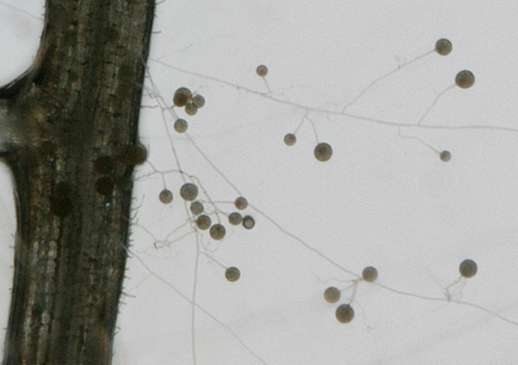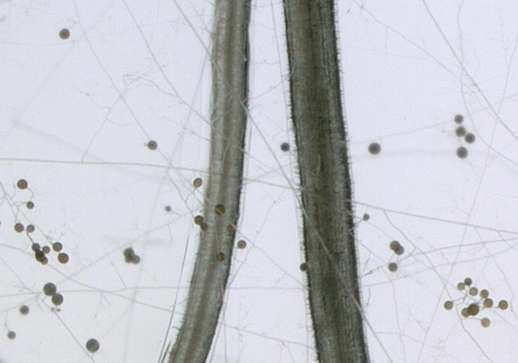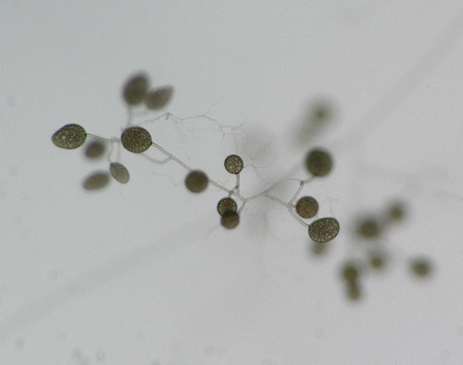'Smoke detector' enables fungal partnership that allowed plants to first survive on land

New research has revealed that a plant protein known to detect growth-promoting compounds in smoke from burning vegetation has a much older and broader role: recognising initial signals sent from the beneficial soil fungi that deliver nutrients directly into plant cells.
By identifying the molecular signals emitted through the soil by friendly fungi, the protein enables a plant to "roll out the red carpet" for cell colonisation by the fungi, and all the survival advantages this mutually-beneficial relationship brings - the fungi feeds minerals such as phosphate into plant cells in return for sugar extraction.
This "symbiosis" between plants and certain microbial fungi is prevalent across the plant kingdom, and thought to date back to the earliest transitions of plant life from water to land some 450 million years ago, as plants had to develop ways of surviving on land by acquiring nutrients from soil many millennia before they evolved roots.
Scientists believe this ancient relationship with fungi was likely critical to the early terrestrial survival of plants, and consequently the evolution of "all higher life on earth".
While previous research had shown that plants can clearly tell the difference between beneficial fungi and those that offer nothing or cause disease, how they make the distinction had proved mysterious. Now, latest research has unravelled the genetic code of the plant protein that enables the "cross-kingdom dialogue" between plants and fungi - allowing plants to let the right fungi in.
Surprisingly, the protein is an enzyme known to science as the receptor for Karrikin, a plant hormone created when vegetation is burned. Karrikin - from karrik, the Aboriginal word for fire - triggers seed germination in certain species of plant known as "fire-chasers": plants that are first to sprout once wildfires have devastated their competitors.

While only those few fire-following species such as eucalyptus and some members of the tobacco family use the protein (called D14L) to "tune into smoke signals", the latest study shows that this same protein is used by the vast majority of plant life on Earth to tune into fungi - perceiving the molecular signals from friendly fungi, and enabling a relationship that helped sustain plant life on land hundreds of millions of years before the evolution of roots and seeds.
"This protein had already been seen to detect smoke hormones in a few fire-chasing plant species, but now we've shown it's the same protein that is central to the everyday interaction of plants with beneficial fungi. This primary, ancestral role of forging a symbiosis with fungi is harnessed by over 80% of all plant species on the planet," said Dr Uta Paszkowski, from Cambridge University's Department of Plant Science, senior author of the study published today in the journal Science.
"Such fungal symbioses assisted plants to make the transition to land. We are beginning to unlock a process which is taking us back to the first stages of plant life on land some 450 million years ago, one of the key evolutionary steps of life on planet Earth," she said.
For the new study, scientists found the first "mutant" rice plant that had no susceptibility at all to the friendly fungi. The team was able to work out the missing gene, and isolated the D14L protein as the critical element for the detection of these fungi in plants.
"Fungi and plants secrete all sorts of molecules, like a dialogue through the soil, and what we captured is the 'hearing' side in plants. Removal of the protein renders the plant insensitive to the fungus - in other words, the plant has become deaf," said Paszkowski.

When colonising a plant, the beneficial fungus blooms within individual plant cells, growing thin tendrils called hyphae that extend into surrounding soil and pump minerals and nutrients straight into the heart of plant cells. Plants colonised by friendly fungi get between 70 to 100% of their phosphate directly from these hyphae, for example. In return, the fungus gets its sugars from the plant.
Plants monitor their surrounding for the presence of other bacterial or fungal invaders normally using 'receptor-kinases'. "We and others had assumed the protein mechanism plants use for identifying beneficial fungi would be related to those," said Paszkowski.
She describes it as a "real surprise" to find the D14L protein, a 'hydrolase' protein which functions deep inside the cell, to be necessary for the communication with the friendly fungi.
As the D14L protein is also involved in plants developmental responses to light Paszkowski talks of a "gut feeling" that - with this ancient protein responding to light, atmosphere (through smoke detection) and soil environment (through fungal symbiosis) - it could have been a developmental crossroads vital to plants' evolutionary leap out of the oceans.
"Light; atmosphere; soil: all aspects crucially different when making that change from water to land, and all adaptations that would be influenced by this one protein. The D14L protein may take us back to the earliest days of life on land," she said.
More information: "Rice perception of symbiotic arbuscular mycorrhizal fungi requires the karrikin receptor complex," DOI: 10.1126/science.aac9715
Journal information: Science
Provided by University of Cambridge




















